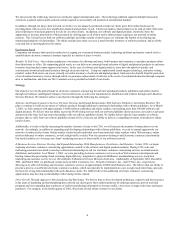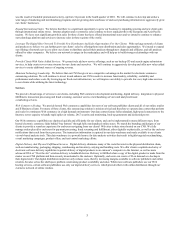Digital River 2002 Annual Report Download - page 20
Download and view the complete annual report
Please find page 20 of the 2002 Digital River annual report below. You can navigate through the pages in the report by either clicking on the pages listed below, or by using the keyword search tool below to find specific information within the annual report.14
our reputation could be harmed. Our contracts with our software publisher clients are generally one to two years in duration, with an automatic
renewal provision for additional one-year periods, unless we are provided with a written notice at least 90 days before the end of the contract. As
is common in our industry, we have no long-term or exclusive contracts or arrangements with any software publishers that guarantee the
availability of software products. Software publishers that currently supply software to us may not continue to do so and we may be unable to
establish new relationships with software publishers to supplement or replace existing relationships.
Our business plans depend on increasing revenue from E-Business clients.
The success of our business strategy depends upon increasing fee and service revenue derived from the sale of non-software products for E-
Business clients. Since initiating sales of electronic commerce outsourcing services in 1999, our E-Business Services Division has incurred only
net losses. We have made substantial investments in technology and infrastructure and we may fail to establish and maintain sufficient
relationships with E-Business clients to offset these expenses. If we are unable to develop and expand our relationships with E-Business clients,
we will fail to grow revenue as projected and the E-Business Services Division will continue to have a negative impact on our profitability.
Implementing our acquisition strategy could result in dilution and operating difficulties.
We have acquired, and intend to continue engaging in strategic acquisitions of, businesses, technologies, services and products, such as
businesses that provide outsourcing services to software publishers. The process of integrating an acquired business, technology, service or
product into our business and operations may result in unforeseen operating difficulties and expenditures. Integration of an acquired business
also may disrupt our ongoing business, distract management and make it difficult to maintain standards, controls and procedures. Moreover, the
anticipated benefits of any acquisition may not be realized. If a significant number of clients of the acquired businesses cease doing business
with us, we would experience lost revenue, and any synergies from the acquisition may be lost. Future acquisitions could result in potentially
dilutive issuances of equity securities, the incurrence of debt, contingent liabilities, amortization expenses of intangible assets or impairment of
goodwill.
Electronic software delivery, or ESD, is still an evolving and unproven technology and the industry may ultimately fail to accept ESD.
Our success will depend in large part on the growth in end-user acceptance of ESD as a method of distributing software products. ESD is a
relatively new method of distributing software products to end-users, and unless ESD gains widespread market acceptance, we will be unable to
achieve our business plan. Factors that will influence the market acceptance of ESD include:
• the availability of sufficient bandwidth, both now and in the future, to enable purchasers to rapidly download software products;
• the cost of time-based Internet access;
• the number and adequacy of software products that are available for purchase through ESD as compared to those available through
physical delivery; and
• the level of end-user comfort with the process of downloading software via the Internet, including the ease of use, lack of concern
about transaction security and technical support.
Even if ESD achieves widespread acceptance, we may be unable to overcome the substantial existing and future technical challenges associated
with electronically delivering software reliably and consistently on a long-term basis. Our failure to do so would also impair our ability to
execute our business plan.
Developments in accounting standards may cause us to increase our recorded expenses, which in turn would jeopardize our ability to
demonstrate sustained profitability.
In July 2001, we adopted Statement of Financial Accounting Standard No. 142, “Goodwill and Other Intangible Assets” (SFAS No. 142). The
statement generally establishes that goodwill and intangible assets with indefinite lives are not amortized but are to be tested on an annual basis
for impairment and, if impaired, are recorded as an impairment charge in income from operations. As of December 31, 2002, we had an
unamortized goodwill with an indefinite life with balance of $18.7 million, primarily from our acquisitions made in previous years. If a
significant portion of this balance is determined for any reason to be impaired, the subsequent accounting of the impaired portion as an expense
would lower our earnings and jeopardize our ability to demonstrate sustained profitability, which could cause our stock price to decline.
























